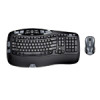Logitech Desktop Wave Role of Comfort in Product Design - Page 3
According to the Japanese Ministry of Health, Labour - machine
 |
View all Logitech Desktop Wave manuals
Add to My Manuals
Save this manual to your list of manuals |
Page 3 highlights
The Role of Comfort in Product Design - Page 3 The reason: internal frames tend to be lighter and easier to balance, supporting the way people naturally move. That's important to the people carrying these packs on their backs for long periods of time or with significant weight inside. The World Health Organization states that eight out of ten people will suffer from lower back pain at some point in their lives. According to the Japanese Ministry of Health, Labour and Welfare, more than 12 million Japanese experience back pain every year. Kelty One hundred years ago, the backpack - or rucksack, as it's Kelty internal frame backpack. sometimes called - consisted of a heavy bag, often made of a coarse fabric such as burlap or canvas, and two straps. For serious trips into the wilderness, or in warfare, the bag allowed people to carry more supplies than with the arms alone, but often at the price of serious physical discomfort. Then in 1920, Lloyd "Trapper" Nelson was sent by the Puget Sound Naval Shipyard to Kodiak, Alaska. After completing his work for the Navy, Nelson took a short leave to hike into the Alaskan wilderness. A member of the local Native American tribe lent him the backpack his tribe had used for generations - a sealskin bag stretched over willow sticks. Though the bag improved on the earlier rucksack - and supported more weight by distributing the load to the willow frame - Nelson lay awake at night, with sore and bloodied shoulders, determined to come up with a better solution. When Nelson returned to Seattle, he purchased an industrial sewing machine and after more than eight years of trial and error, developed a design that incorporated the wooden frame with the rucksack. He was the first to commercialize the frame backpack in the U.S and within a year, the U.S. Forest Service wanted 1,000 TragerUSA Trager external frame backpack. Trapper Nelson's Indian Pack Boards. Kelty external frame backpack. In the early '50s, Dick Kelty improved upon Trapper's external frame design by using aluminum instead of wood in the frame, as well as adding a hip belt. Kelty's innovations reduced the frame weight and, with the hip belt, transferred some weight from the back to the hips. In the early '70s, Greg Lowe introduced the Lowe 1972 Alpine Systems Expedition. This backpack featured interior aluminum stays (inspired by earlier internal-frame packs from Europe). Because internals sit closer to the body, they are much easier to use during popular outdoor sports, such as rock climbing or snow shoeing, that require good balance; for the same activities, the external frame might easily tip over or even cause the athlete to tip over. Kelty







